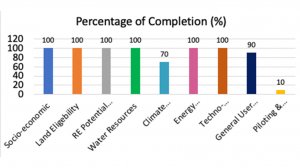JOHANNESBURG (miningweekly.com) – With close to 90% of all the datasets for the Southern African green hydrogen atlas having been collected, its official launch will definitely take place before year-end, Sasscal executive director Dr Jane Olwoch assured Engineering News & Mining Weekly in a Zoom interview on Monday.
Moreover, Olwoch enthused that there were already clear signs of the cost of Southern Africa’s green hydrogen being attractively low.
A team of developers will be highlighting the green hydrogen hot spots of the Southern African Development Community (SADC) at a workshop in Windhoek this week. (Also watch attached Creamer Media video.)
Olwoch expects the workshop to endorse the atlas data ahead of its official launch in possibly September or October.
“Definitely, before the end of this year, we’ll launch this amazing atlas,” Olwoch assured.
Zero-carbon green hydrogen is generated by using renewable energy to separate water into hydrogen and oxygen, with sea water the predominant water targeted.
The German-funded project integrates the SADC region ahead of the already apparent opening up of a multitrillion-dollar green hydrogen market, along with significant job creation.
The project is placing Southern Africa on the road to contributing meaningfully to global Sustainable Development Goals, with €5.7-million having been made available by the German Federal Ministry of Education and Research (BMBF).
H2Atlas-Africa is the first phase of BMBF’s ‘Go Green Go Africa Hydrogen’ initiative, with the starting point of the process validating green hydrogen hot spots, which is expected to be followed by the building of pilot plants able to demonstrate the competitiveness of Southern African green hydrogen generation ahead of commercialisation.
H2Atlas-Southern Africa is focused on the assessment of the potential to generate hydrogen in sub-Saharan Africa from the renewable energy resources in the region.
“In this assessment we focused on detailed technological, environmental, economic, and social feasibility assessment. We also considered present and future local energy use and demand, not to mention future climate projections,” said Olwoch.
This work on 12 SADC countries involved 60 experts in the region and about 16 or more developers and mathematical modellers from the Forschungszentrum Jülich research institution in Germany.
The 12 SADC countries that have participated are Angola, Botswana, Democratic Republic of Congo, Eswatini, Malawi, Mauritius, Mozambique, Namibia, South Africa, Tanzania, Zambia and Zimbabwe.
The current global focus on green hydrogen as the next universal energy carrier has served to also highlight the value of Southern Africa’s huge platinum group metals (PGMs) endowment, which goes hand-in-hand with the green hydrogen economy, both in terms of the PGM metals used in the electrolysers that produce green hydrogen, but also in terms of the platinum used in the hydrogen fuel cells that provide mobility, stationary power generation and heating in a very wide range of industrial, agricultural, commercial and residential applications. Platinum could see at least 400 000 oz/y of demand from the green hydrogen sector, the World Platinum Investment Council estimates.
The Hydrogen Atlas Africa project coordinator is Dr Solomon Agbo, who will be playing a prominent role at the workshop. In an earlier interview with Engineering News & Mining Weekly, Nigerian-born Agbo, the corporate development unit scientist at Forschungszentrum Jülich, emphasised the importance of international collaboration and government-private sector partnership in the development of the green hydrogen economy.
Mining Weekly: What, in your view, should be the next step that Southern Africans should take?
Olwoch: As a result of the excellent partnership and increased trust between Sasscal and BMBF, we initiated a trip of BMBF to Namibia and South Africa in the middle of Covid, in October 2020.
In Namibia, we visited key Ministries and held a broader workshop for stakeholders. The aim of the visit of Dr Stefan Kaufmann and Dr Christoph Rövekamp was to meet stakeholders and government officials that are willing to partner with Germany in funding and implementing big pilot projects.
In 2021, Namibia and Germany signed a joint communique of intent (JCol) for the two nations to cooperate in areas related to renewable energy and green hydrogen.
In the JCoI, BMBF committed €40-million to fund renewable energy and green hydrogen projects. There are three types of green hydrogen projects identified to be funded by the BMBF in Namibia – Development of the Namibia Green Hydrogen Strategy, Pilots Projects, and Youth for Green Hydrogen – a scholarship programme for Namibian Youth. I’m very happy to report that this year, BMBF, the Namibia government, and Sasscal launched the three projects and, to date, we have completed the strategy process and contracted McKinsey to develop the Namibia Green Hydrogen Strategy.
For the pilot projects, we’ve received 27 proposals and very soon the selection process will also be completed and subsequently launched. This is very exciting because the pilots are very big projects with a value of €30-million committed by the BMBF.
We’ve also made progress with the scholarships. We have issued a call and we received 1 154 applicants. We’re busy with the selection and hope for the process to be completed by end of September. The scholarships include both MSc programmes in renewable energy and green hydrogen and diplomas and certificates in vocational training. The plan is that most of the training will be done at Namibian universities, with a few months at German universities.
For Sasscol, as the implementor of the JCoI, we must deliver because it is a great opportunity to have been trusted by the BMBF and Namibia government to support them in implementing these amazing projects.
Furthermore, personally, I’ve never seen such practical commitment that has been demonstrated by the German government through BMBF.
This is what is required from all developed nations – reduction in greenhouse gases is the responsibility of all of us and BMBF has time and again demonstrated that Africa isn’t alone in this journey.
So, yes, we have gone many steps further, even before the launch of the atlas, because we’re very confident of Namibia’s solar and wind resources, land eligibility, ports, and government support. In South Africa, BMBF is also behind the big project with Sasol for production of green kerosene. Exciting times for green hydrogen and cooperation between nations.
SOUTH AFRICAN TEAM
As reported by Engineering News & Mining Weekly in September 2020, South Africa’s national green hydrogen team structure is made up of people including:
Dr Rebecca Maserumule, chief director: hydrogen and energy, Department of Science and Innovation (DSI);
Professor Timothy Dube of the University of the Western Cape;
Dr Darija Susac, research and technology development manager for fuel cells and electrolysers and key programme manager, Hydrogen South Africa (HySA) Catalysis, DSI Centre of Competency, University of Cape Town;
Crescent Mushwana, Energy Systems, Council for Scientific and Industrial Research (CSIR) Energy Centre;
Dr Minesh Bipath, of the South African National Energy Development Institute, who is leading the hydrogen road map work for South Africa;
Nomthandazo Mabena of the CSIR, who is working in battery storage technologies and fuel cells;
Thomas Roos, a senior CSIR researcher, who has been leading CSIR work on green hydrogen export opportunities for South Africa; and
Dr Dmitri Bessarabov of North-West University, who leads HySA Infrastructure in South Africa, under the DSI.
“The green hydrogen export market potential is much larger than the local green electricity market,” Roos stated in the Hydrogen, Fuel Cells & the Green Economy feature some time back in Engineering News & Mining Weekly.
“Renewable projects built for hydrogen production might even be a way for South Africa to subsidise the strengthening of its physical transmission grid, reducing the cost to the fiscus or existing electricity consumers,” Roos added.
In the same feature, Bessarabov stated: “Water electrolysis can be used to produce hydrogen gas on a large scale. This hydrogen can be stored in different forms and subsequently used in various sectors.”
HySA Infrastructure is leading research and development efforts in South Africa in water electrolysis, based on polymer electrolyte membrane (PEM) electrolysis technology, in which deionised water is spilt into hydrogen and oxygen on the application of an electric current.
Oxygen and protons are generated at the anode that contains iridium-based electrocatalyst. Iridium is a PGM. At the cathode, the protons that pass through the PEM are reduced by electrons to form hydrogen gas at a platinum-based electrocatalyst.
“Given the fact that the global water volume is estimated to be around 1.4 × 109 km3, hydrogen could be seen as an almost everlasting resource,” Bessarabov added.
In the same feature, venture capital company AP Ventures said: “As a renewable energy-rich country, South Africa has the potential to be a leading global source of low-cost green hydrogen, which offers the exciting economic opportunity to create a long-lasting sustainable industry powered by PGMs, both domestically and internationally.”
AP Ventures described hydrogen as providing domestic energy resilience, creating new high-technology jobs and providing a tangible route to decarbonise at residential and industrial levels.
“Hydrogen offers the opportunity to unlock investment into South Africa and create employment plus a competitive export market. Liquid organic hydrogen carrier technology is a key enabler to link the potential of South African low-cost green hydrogen production, both with domestic demand and to international markets. Recognising this valuable opportunity, we and our investors are working to make the hydrogen economy a reality both in South Africa and worldwide,” stated AP Ventures, the investors of which are the Public Investment Corporation of South Africa, Anglo American Platinum, Mitsubishi Corporation, the Toyota-linked Mirai Creation Fund and Plastic Omnium.
EMAIL THIS ARTICLE SAVE THIS ARTICLE ARTICLE ENQUIRY
To subscribe email subscriptions@creamermedia.co.za or click here
To advertise email advertising@creamermedia.co.za or click here
















